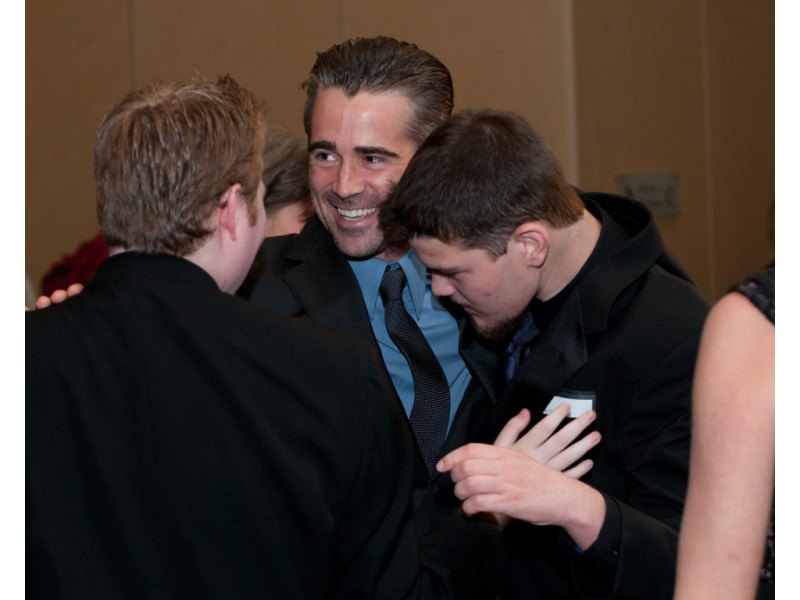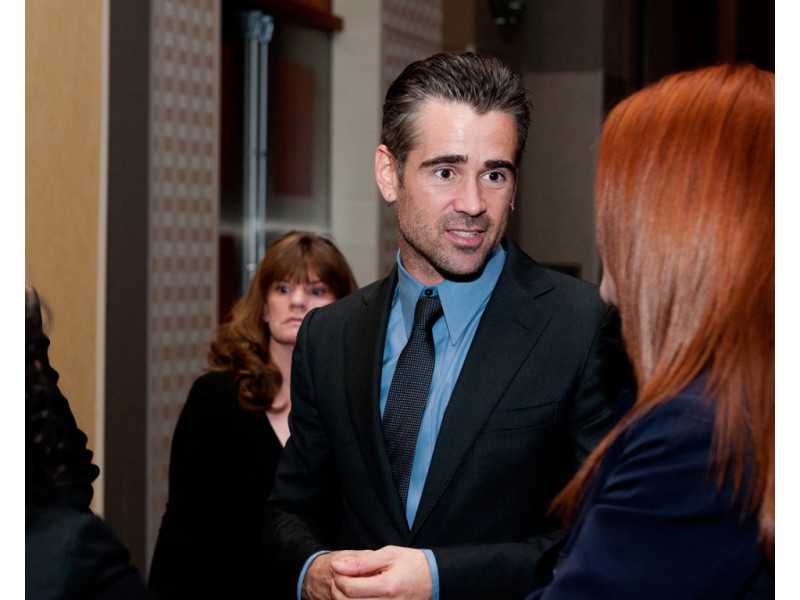Angelman Syndrome: Colin Farrell Son Angelman Syndrome

Angelman syndrome is a rare neurogenetic disorder that affects the nervous system and causes a range of developmental and physical challenges. It is characterized by a unique set of symptoms, including developmental delays, intellectual disability, speech impairment, and characteristic behavioral traits. This syndrome arises from a genetic mutation that disrupts the function of a specific gene, known as the UBE3A gene.
Genetic and Neurological Aspects
Angelman syndrome is caused by a genetic mutation affecting the UBE3A gene, located on chromosome 15. This gene plays a crucial role in the production of a protein essential for the proper development and function of the nervous system. The majority of cases (approximately 70%) are caused by a deletion of a portion of chromosome 15, encompassing the UBE3A gene. In other cases, the syndrome may arise due to mutations within the UBE3A gene itself, maternal uniparental disomy (where the individual inherits two copies of chromosome 15 from their mother), or imprinting defects that prevent the maternal copy of the UBE3A gene from being expressed.
Symptoms and Challenges
Individuals with Angelman syndrome present with a distinctive set of symptoms that contribute to their unique challenges.
Developmental and Cognitive Impacts
- Developmental Delays: Individuals with Angelman syndrome typically exhibit significant developmental delays, particularly in motor skills, language development, and cognitive abilities. These delays are often evident in early childhood and persist throughout life.
- Intellectual Disability: The syndrome is associated with intellectual disability, varying in severity from mild to profound. This impacts an individual’s ability to learn, understand, and reason.
- Speech Impairment: Speech development is significantly affected in Angelman syndrome. Individuals often have limited verbal communication abilities, with a characteristic “happy demeanor” and frequent laughter. Their speech may be delayed, limited, or absent, making communication a significant challenge.
Behavioral Characteristics
- Happy Demeanor: Individuals with Angelman syndrome are often described as having a “happy demeanor,” characterized by frequent smiling, laughter, and an overall cheerful disposition. This distinctive trait is a hallmark of the syndrome.
- Hyperactivity: Hyperactivity is a common characteristic, with individuals often exhibiting increased energy levels, restlessness, and difficulty staying still.
- Hand-Flapping: Repetitive hand-flapping movements are frequently observed in individuals with Angelman syndrome. This behavior is thought to be a form of self-stimulation or a way to express excitement or joy.
- Seizures: Seizures are a common complication of Angelman syndrome, occurring in approximately 80% of individuals. The type and frequency of seizures can vary significantly.
- Sleep Disturbances: Sleep disturbances are common, with individuals often experiencing difficulty falling asleep, staying asleep, or having abnormal sleep patterns.
Physical Characteristics
- Ataxia: Ataxia, a lack of coordination, is a common feature, leading to difficulty with balance, walking, and fine motor skills.
- Facial Features: Individuals with Angelman syndrome often have distinct facial features, including a wide mouth, a prominent chin, and widely spaced eyes. These features are not always present, but they can contribute to the syndrome’s unique appearance.
- Scoliosis: Scoliosis, a curvature of the spine, can occur in some individuals with Angelman syndrome.
Living with Angelman Syndrome

Living with Angelman syndrome presents a unique set of challenges and strengths. Individuals with Angelman syndrome and their families navigate a complex landscape of developmental, physical, and social aspects. While the challenges are real, the strengths and abilities of those with Angelman syndrome often shine brightly, showcasing their resilience and joy.
Challenges Faced by Individuals with Angelman Syndrome and Their Families, Colin farrell son angelman syndrome
The challenges faced by individuals with Angelman syndrome and their families are multifaceted. These challenges are often intertwined, creating a complex tapestry of needs and adjustments.
- Developmental Delays: Individuals with Angelman syndrome often experience developmental delays, impacting their cognitive, motor, and speech skills. This can lead to difficulties in learning, communication, and independent living.
- Seizures: A significant number of individuals with Angelman syndrome experience seizures, which can range in frequency and severity. Seizures can impact cognitive function, behavior, and overall well-being, requiring ongoing medical management.
- Sleep Disturbances: Sleep disturbances are common in individuals with Angelman syndrome, leading to fatigue, irritability, and difficulty with daily routines. This can impact the entire family’s well-being, as caregivers often experience sleep deprivation.
- Behavioral Challenges: Individuals with Angelman syndrome may exhibit behavioral challenges, such as hyperactivity, impulsivity, and difficulty with social interactions. These challenges can require specialized interventions and support to manage and promote positive behaviors.
- Social Integration: Social integration can be challenging for individuals with Angelman syndrome due to their communication and social interaction difficulties. This can lead to feelings of isolation and difficulty forming meaningful connections with peers.
- Medical Management: Managing Angelman syndrome often involves a multidisciplinary team of healthcare professionals, including neurologists, pediatricians, therapists, and specialists. This can be time-consuming and require significant coordination, adding to the challenges faced by families.
Strengths and Unique Abilities
Despite the challenges, individuals with Angelman syndrome possess remarkable strengths and unique abilities that often contribute to their joy and well-being. These strengths can be nurtured and celebrated, fostering a sense of empowerment and accomplishment.
- Happy and Joyful Disposition: Individuals with Angelman syndrome are often known for their infectious laughter and happy disposition. Their positive outlook and enthusiasm can brighten the lives of those around them.
- Strong Social Bonds: Despite social interaction challenges, individuals with Angelman syndrome often develop strong bonds with family and caregivers. Their affectionate nature and desire for connection contribute to their social well-being.
- Creative Expression: Many individuals with Angelman syndrome demonstrate a unique talent for creative expression, often through art, music, or dance. Their artistic endeavors can provide a powerful outlet for self-expression and communication.
- Resilience and Determination: Individuals with Angelman syndrome often display remarkable resilience and determination in overcoming challenges. Their ability to adapt and persevere is a testament to their strength and spirit.
- Ability to Learn and Grow: With appropriate support and interventions, individuals with Angelman syndrome can learn and grow. Their progress may be at a different pace, but their capacity for learning and development is often inspiring.
Inspiring Stories and Examples
The stories of individuals with Angelman syndrome thriving in their lives are a testament to their resilience, determination, and the power of love and support. These stories inspire hope and demonstrate the incredible potential that lies within each individual.
“Angelman syndrome may present challenges, but it doesn’t define the person. The joy, love, and resilience of individuals with Angelman syndrome are truly remarkable.” – Dr. [Name], Angelman Syndrome Specialist
- [Name]: [Name] is an individual with Angelman syndrome who has overcome numerous challenges to pursue his passion for music. He has learned to play the guitar and has even written his own songs, sharing his talent with the world.
- [Name]: [Name] is an artist with Angelman syndrome who uses her art to express her emotions and connect with others. Her vibrant paintings and sculptures have been exhibited in galleries and have touched the hearts of many.
- [Name]: [Name] is an individual with Angelman syndrome who has achieved significant progress in his communication skills. He has learned to use assistive technology to communicate his thoughts and feelings, allowing him to connect with others in a meaningful way.
Colin farrell son angelman syndrome – Colin Farrell’s son, Henry, was diagnosed with Angelman syndrome, a complex genetic disorder that affects development. The condition, while challenging, doesn’t define Henry; he lives a vibrant life, much like the intricate carvings on a chippendale chair back , each detail adding to its beauty.
Just as the chair’s design tells a story, Henry’s journey with Angelman syndrome reveals his unique spirit and resilience, a testament to the beauty that can emerge from unexpected circumstances.
Colin Farrell’s son, Henry, has Angelman syndrome, a rare genetic disorder that affects the nervous system. It’s a challenging condition, but Henry’s story is a testament to the strength and resilience of both him and his family. Imagine, for a moment, sitting on a comfortable polywood curved back adirondack chair in the backyard, watching Henry play, his laughter echoing in the air.
It’s a simple image, yet it speaks volumes about the joy and normalcy that can exist even in the face of adversity. Colin Farrell’s love for his son is a constant reminder that even in the darkest of times, hope and happiness can blossom.